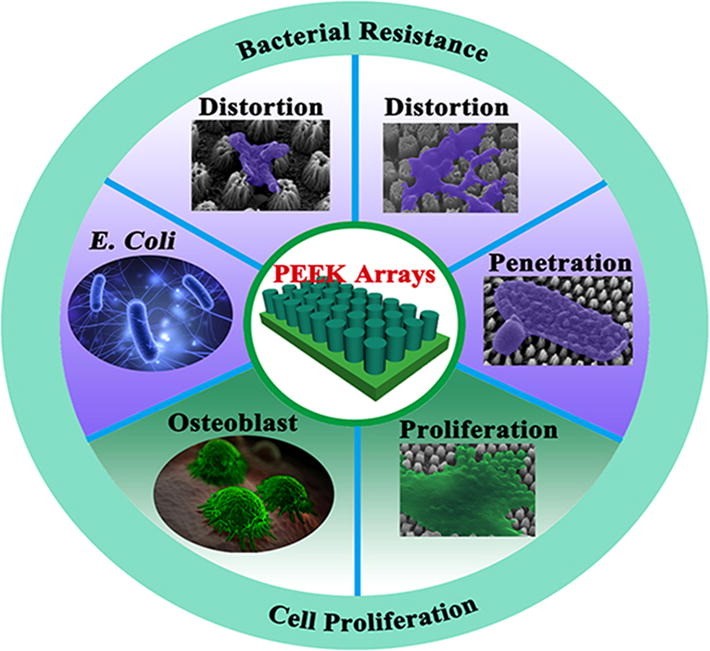
Chemical Engineering Journal 392 ( 2020 )123736
为了减轻手术后细菌感染,对于生物医学工程来说,具有抵抗细菌和骨传导性的植入物是理想的。以往可以引入杀菌剂和抗生素,但存在潜在的副作用,例如毒性和耐药性令人担心。从某些自然表面微观结构(如昆虫的翅膀)观察到了抗菌行为,从而促进了对新抗菌方法的研究,而无需使用外来化学物质。胶体光刻技术是制备纳米和微米尺寸阵列的灵活技术。结合等离子刻蚀,胶体光刻已被用于通过调整掩模尺寸,等离子源和刻蚀工艺来制备各种表面结构。更重要的是,这是一种表面工程技术,不会改变材料的有利体积特性,因此对生物材料非常有吸引力。
近日,香港城市大学物理及材料科学与工程学院 朱剑豪 团队受昆虫翅膀上天然抗菌结构的启发,通过胶体光刻和等离子刻蚀技术在PEEK表面可控地制备了锥/柱形微/纳米阵列,并研究了材料表面的抗菌性能和生物相容性。经表面工程改造的PEEK具有增强的抗菌性能,其潜在机理取决于表面形貌和表面结构尺寸。关于微阵列,早期的机械拉伸作用和随后的尺寸作用都有助于总体的抗菌作用。另一方面,模仿蝉翼的纳米阵列仅通过渗透作用就能杀死细菌。从改性的PEEK表面也观察到成骨细胞的增殖增强,使其适于植入材料。从这项工作得出的抗菌原理为具有抗菌能力和生物相容性的生物启发性生物材料的设计和制造提供了思路。
In order to mitigate post-surgery bacterial infection, implants with both bacteria resistance and osteoconductivity are desirable for biomedical engineering. Bactericidal agents and antibiotics can be introduced but there are potential side effects such as toxicity and development of bacterial resistance. The antibacterial behavior has been observed from some natural surfaces such as insect wings consequently spurring research of new antibacterial methods without the use of extraneous chemicals. Colloidal lithography is a flexible technique to prepare arrays with nano and micro dimensions. Combined with plasma etching, colloidal lithography has been utilized to prepare various surface structures by adjusting the mask size,plasma source, and etching process. More importantly, it is a surface engineering technique that does not alter the favorable bulk attributes of the materials and therefore, it is very attractive to biomaterials.Recently, to tackle this challenge, an interesting report by team of Jianhao Zhu, School of Physics and Materials Science and Engineering, City University of Hong Kong Inspired by the natural antibacterial structure on insect wings,cone/pillar-like micro/nano-arrays are fabricated controllably on PEEK by colloidal lithography and plasma etching and the resulting bacterial resistance and biocompatibility are investigated. The surface-engineered PEEK possesses enhanced antibacterial properties and the underlying mechanism depends on the surface topography and dimensions of the surface structures. With regard to the microarrays, both the early mechanical stretching effect and subsequent dimensional effect contribute to the overall antibacterial effects. On the otherhand, the nanoarrays that mimic cicada wings kill bacteria solely by the penetration effect. Enhanced proliferation of osteoblasts is also observed from the modified PEEK rendering it suitable for implant materials. The antibacterial principles concluded from this work provide insights into the design and fabrication of bio-inspired biomaterials with improved bacteria resistance and biocompatibility.
DOI:https://doi.org/10.1016/j.cej.2019.123736
高承哲